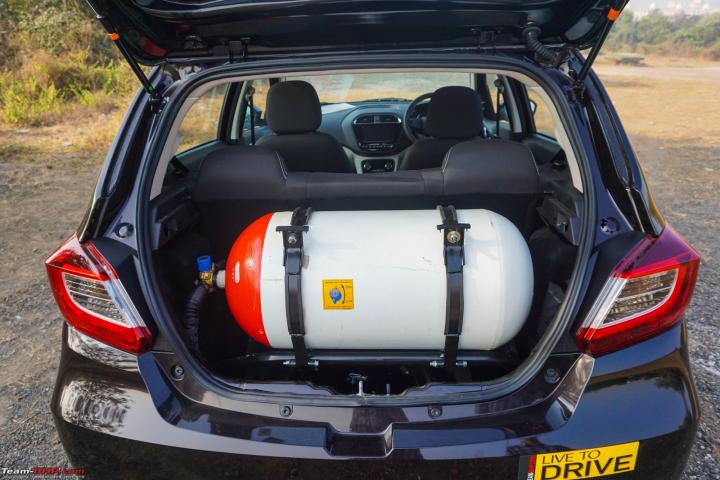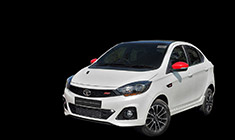News
Tata Tiago: Adding a boot lamp for just 96 rupees
After two days of usage, I have a complaint. The bulb is dim and a LOT of light is being lost to the rear of the lamp into the dead space behind the panel.
BHPian lemedico recently shared this with other enthusiasts.
The Tiago is a DIYer’s dream. I have frequently found bits and bobs to do with the car ever since I got it a year ago. Mine is a 2021 XZA+ AMT DT. The most expensive and supposedly top-specced of the lot. Yet, it lacks so much on the interior and the exterior! One may read through the TeamBHP threads and/or watch my uploads on YouTube for all the DIY I have done so far. A few examples are a front armrest, auto-dimming IRVM, parcel-tray strings and a rear 12v socket.
- Front armrest
- Parcel tray strings
- 12V rear socket
- Auto dimming IRVM
- AMT Hydraulic oil change
- Padded door armrests
This time, I went about installing an OEM boot lamp. Perhaps the older models had one because there are slots for lamps on both the left- and right-hand side. Or maybe it is a panel part shared with the Tigor, which has a boot lamp.


Inspired by this video
and dissatisfied with my own “jugaad” lamp, I went about getting things bought and ready for this DIY. My earlier attempt to Velcro a push-button LED spot lamp was not up to OEM standards, as one may see in this video.
Once again, I found myself heading to the Maruti workshop for a part to be fitted on a Tata car! The lamp is ditto amongst at least these two company’s cars. And it costs much less too. The Tata OEM lamp is Rs. 144 plus a shipping charge and a minimum order value of Rs. 399 from the website.
The identical one from Maruti is ₹96 over the counter! Please note that the shapes of the left and right-side lamps are not similar. This one would only fit in the slot on the right-hand side of the boot.


Other things needed:
- 2.5 metres of wire. This cost me ₹20.
- long flat-head screwdriver
- short cross-head screwdriver
- electrical insulation tape
- super glue/glue gun
- soldering iron, flux, and wire
- optional extra-long laparoscopic forceps to snake the wire through
you may or may not disconnect the battery. I did not.
Start by removing the cabin lamp with a flat-head screwdriver. It comes off easily.
Unscrew two + type screws of the lamp’s frame and pull the lamp’s harness outwards
Snake the wire towards the right-side B-pillar
Take the wire towards the rear C-pillar

Unfasten the panel fascia on the C-pillar. There are two yellow clips that are easily undone with a long flat-head screwdriver.

Bring the wire out through the slot for the lamp and replace the weather strips.

Make the connections on the cabin lamp. The black wire is neutral, and you merely need to slide in some exposed wire to make a connection. There is no need to splice or cut any original wires! Glue them together and tape them up for double security.




Continue reading BHPian Lemdico's D.I.Y report for more insights and information.
- Tags:
- Indian
- Tata Tiago
- boot lamp
- DIY
News
Stray dogs chewed off wires on my new Tata Tiago EV, had to call RSA
Tata Motors should have provided some kind of protection/shield for these cables if they wanted to price them for an arm and a leg.
BHPian tushar_chand recently shared this with other enthusiasts.
It's been a little over a month since we got our Tiago EV delivered. We got it as a daily commute for my father replacing our 12-year-old Santro Xing. Over this time period, the car has done over 2400 Kms. The first service was done as per schedule.
Last week saw the Tiago EV being out of action for 6 days and was charged to 100% before being parked for the week. Yesterday when my father tried to start it up, it showed the HV Critical error. We tried starting again multiple times, switching the regen to 0 but nothing worked. When we called our service advisor he suggested to try charging the battery.
This seemed absurd and impossible because due to some circumstances it was not parked in its usual spot which meant it was away from its charging point. My father felt visiting the service centre was the right thing to do, given it's just a month-old car. RSA was called and a tow truck was arranged to pick up the car from our home!
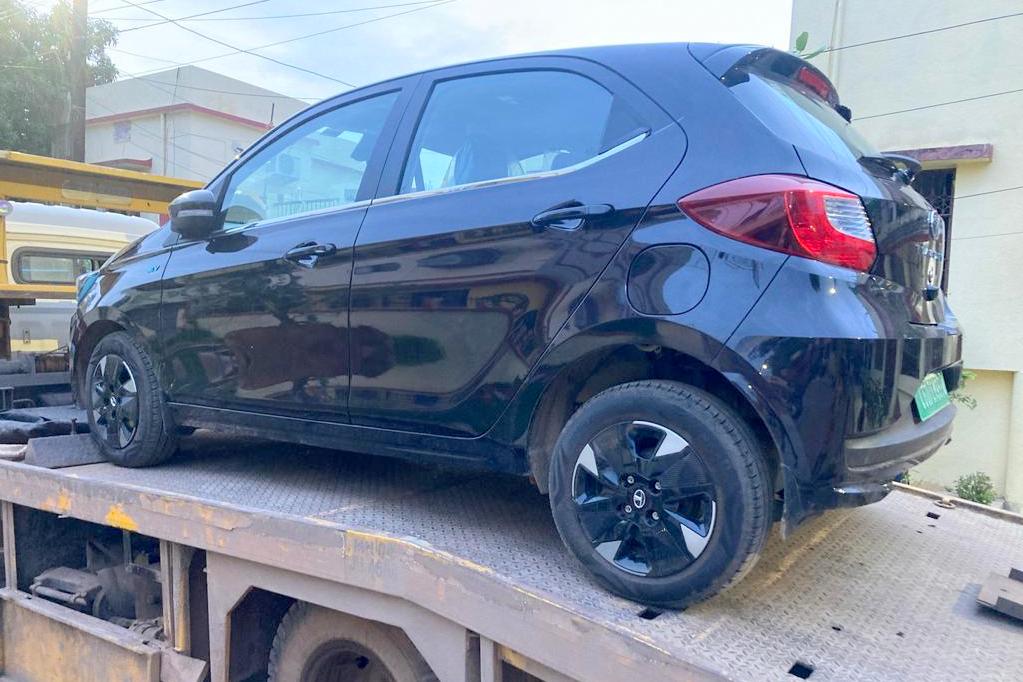
Since it was late in the evening on a Saturday when the car was dropped off at the service centre and Sunday being a holiday, they are yet to take a look. I will be updating as and when I receive them.
I would like to know your opinions, and recommendations on this issue. Any guesses as to why this issue might have happened?
Update
It was the stray dogs who had bitten off the wires coming from MCU. Thankfully they were not able to inflict critical damage to the HV cables. As it turns out the HV cables are even more expensive than what you will think them to be. TATA should've provided some shielding to these cables if they wanted to price them for an arm and a leg.
Has anyone got any idea about retrofitting underbody protection?
Here's what BHPian EV Fan had to say about the matter:
That is a critical concern not just for Tata but almost all the EVs. The connectors & cables all are waterproof but still exposed and chewable in literally all the EVs.
So was it covered under warranty or insurance? Also, if it was covered under warranty, then will they cover it under Insurance once the warranty expires?
IP ratings do not protect against rats & dogs, we might need a new rating.
Here's what BHPian aim120 had to say about the matter:
Are you sure it was the dogs who chewed it, bandicoot rats also chew through big wires easily.
Check out BHPian comments for more insights and information.
News
How a simple mistake by me during DIY caused EPS failure on my Tiago
I was very relieved to see the damage was minor and not youtube grade destructive.
BHPian lemedico recently shared this with other enthusiasts.
My 2021 Tiago AMT one morning gave me a massive sulk. I fired her up and after slotting into Drive, the wheel wouldn't turn as it did. It was ancient truck-like and impossible to even drive up to my mechanic's garage.
I have been an avid DIYer and I got around to fixing it immediately. One thing was for sure, there were no rat bites. I had already rummaged around the cabin and engine compartment to look for obvious signs of rodents.
There weren't any fault codes or warning lamps on my OBD2 scanner or instrument console respectively. This was very weird indeed.
A few youtube video searches gave me diagnoses ranging from oil leak, and sensor failure to steering rack replacement and whatnot.
A few months ago, I created a rear 12v power socket for this car.
I had then fuse tapped the EPAS {electronic power steering assist} fuse for the wiring. Just last night, I had used my tyre inflator to top up air and I suspected maybe that did some damage.
I opened up the cabin fuse compartment, whacked out the fuse tap and voila, there was a blown EPAS 5A fuse! I was very relieved to see the damage was minor and not youtube grade destructive.
There are spare fuses in the engine fuse compartment. I simply swapped it out and the job was done. Lesson learnt, not to use such high voltage accessories in the rear socket.
Have a look at this video I recorded for your better understanding of the task
Here's what BHPian Reinhard had to say on the matter:
This is a bit odd. If there was extra current drawn by the accessory socket - the fuse for the accessory should have blown in the tap (i.e. the one on top), not the EPAS fuse. I wonder why that happened. Was this the first time that you used that newly added socket? I wonder in case there was a short somewhere in the tap already.
Also - if the accessories that you intend to connect to that socket are powerful enough to draw more than 5Amp - you should ideally use a different primary fuse socket, that supports 10 or 15 Amp on Ignition mode. Not a 5 Ampere fuse. Although this is more theoretical and chance of the wiring for the EPAS fuse circuit being different than the others are less - its a chance that car makers try to save every possible cent.
Its not the voltage - voltage for any car accessory will typically be 12V not more. Its the power and current draw that matters. Your accessory pulled more than 5 Amp current. (Still I don't see why it blew a fuse that is for something else).
I'd suggest keep an eye, and in fact keep a spare fuse added back in your car. If the EPAS fuse blows again - go straight to the ASC (after removing that fuse tap) - and get it checked. I think the EPAS-Immobilizer cabin fuse is shared. There might be an actual malfunction in those circuits that could have caused the blow-out, if not a short circuit earlier.
Read BHPian comments for more insights and information.
- Tags:
- Indian
- Tata Tiago
- power steering
News
Tata Tiago plagued with multiple issues: ASC unclear on the cause
Starting the Tiago up, she noticed that the battery light and check engine light were on;
BHPian ExtremePocca recently shared this with other enthusiasts.
Hello everybody!
A close relative of mine has been facing some major issues with her 2022 Tiago XZ+ Petrol MT. It all kicked off when she noticed a pungent odor emanating from somewhere within the car. This happened just after the car had it's 8k kms service. The guys from the service center said they would adjust some AC knobs and fix it. My relative decided not to go the SC as she felt the smell had decreased by a considerable amount and was barely noticeable. All was fine for a few months until she called me in a panic stating that the car would not turn off even after removing the key. She said that after turning the key multiple times, the car eventually turned off. I wasn't there during the time of this incident and was informed after the car had turned off so I can't rule out the possibility of it just being a particularly loud fan. This incident happened at a rather inconvenient time though as she was going to be out of station for around 5 days and was supposed to be driven to the airport by her driver in the Tiago (She drives it herself 95% of the time).
The day of the flight, she had decided to take her husband's Baleno. To get the Baleno out of the garage, she had to reverse the Tiago first. Starting the Tiago up, she noticed that the Battery light and Check engine light were on; apart from this though, the car functioned as normal. No weird smells, no weird noises. After she returned, she drove the car for around 4 days without any issues, the battery light remained on and the check engine light turned on intermittently. Yesterday the check engine light made a return. I advised her to retire the car for the time being until she got it checked by the guys at the SC but, her husband's Baleno was involved in a crash with a learner driver who erratically stopped once the light turned red in the middle of an intersection; this meant that she had to drive the Tiago all the way to airport to drop off her husband. During the drive, both complained that the AC had stopped working and was blowing warm air regardless of the temperature. Not sure if the CEL was on during this time but the battery light definitely was. This leads me to believe that the Serpentine belt which spins both the AC compressor and the alternator has conked off. Not sure if my hypothesis is correct as a failure of the serpentine belt would also disable the power steering. Car will be given to the SC tomorrow.
Update:
So far, the experience has not been the greatest. My relative handed over the car to the service center. First time, they claimed that the battery needed to be topped up. They handed the car back and after a few minutes of driving, the check engine and battery light made it's return.
She decided to drive the car for a few more weeks. Over the course of those weeks both the battery light and CEL disappeared and reappeared intermittently. She decided to get the car checked again. The guys at the SC cleared some codes (one had something to do with the speedometer and the other two had no description). The guy clearing the codes turned the car on after clearing them and no lights returned. Curiously though, the usual suspects returned after we left the service center. The AC stopped working as well. We stopped the car by the side of the road and turned it off. Everything turned off apart from the infotainment system. This issue went after turning the car back on though. The AC started working again but the lights remained. The service deduced that this was a battery issue and that if faced problems again, we would need to replace the battery.
Armed with this new advice, my aunt made her way to the Amaron battery center the SA referred to. The folk at the battery center were extremely impolite and firmly claimed that the problem was with the car. Nevertheless, we handed over our battery to check and given a "service" battery. So far its been around a week and the battery center has not updated us about the progress with the battery. Car seems to be running perfectly on their "service" battery. Don't really know what to say to be honest. The car turned a year old a few days ago and hit 10k around that same time. A battery should not go bad in just a year. The SC guys said nothing else is wrong with the car other than the battery and the battery center said the car is to blame. Tata might get everything else right but if they make mistakes like this in the after sales service, they shoot themselves in the foot.
Check out BHPian comments for more insights and information.
Picture used is for representation purposes only.
- Tags:
- Indian
- Tata Tiago
- Hatchback
News
Tata Tiago, Tigor launched with twin-cylinder CNG tank tech
The Tiago iCNG is priced from Rs. 6.55 lakh, while the Tigor iCNG range starts at Rs. 7.80 lakh (ex-showroom).
Tata Motors has updated the Tiago and Tigor iCNG with its dual-cylinder CNG tank technology. The Tiago iCNG is available in seven variants priced between Rs. 6,54,900 and Rs. 8,09,900, while the Tigor iCNG comes in four trims priced between Rs. 7,79,900 and Rs. 8,94,900 (ex-showroom).
Instead of a single large CNG cylinder that hogs up space in the boot, Tata uses two smaller cylinders that fit under the luggage area. Thanks to this, the Tigor iCNG offers a CNG tank capacity of 70 litres. The Altroz iCNG and the recently launched Punch iCNG also have a similar setup.
The Tiago and Tigor iCNG is powered by a 1.2-litre, 3-cylinder engine that produces 72 BHP @ 6,000 rpm and 95 Nm @ 3,500 rpm in CNG mode. When running on petrol, the engine develops 85 BHP and 113 Nm and comes paired with a 5-speed manual gearbox.
Tata Tiago iCNG ex-showroom prices:
- XE – Rs. 6,54,900
- XM – Rs. 6,89,900
- XT – Rs. 7,34,900
- XZ+ - Rs. 8,09,900
- XZ+ DT – Rs. 8,19,900
- XT NRG – Rs. 7,64,900
- XZ NRG – Rs. 8,09,900
Tata Tigor iCNG ex-showroom prices:
- XM – Rs. 7,79,900
- XZ – Rs. 8,19,900
- XZ+ - Rs. 8,84,900
- XZ+ LP – Rs. 8,94,900
- Tags:
- Indian
- Tata Tiago
- Tata Tigor
- CNG
News
Tata Tiago long-term review including mileage, AC & aftersales service
I have driven it for 70,000 km & I would say it’s a nice car with great potential but there is a reason I am selling it now.
BHPian Singh09 recently shared this with other enthusiasts.
It’s been a long time since I have updated this thread. Tiago has completed 70k on the ODO and still going strong except for some tits and bits. So, I thought that it is a perfect time for a long-term ownership review as I have driven it extensively in the city, on highways, in the mountains and a few thousand kilometers at off-beat locations with no tarmac.
Engine & Transmission
Well, the 3-cylinder engine mated to a 5-speed manual transmission in Tiago has its own benefits and disadvantages. It produces enough low-end torque to keep you moving in the city with ease in 2nd or 3rd gear. If you just floor the pedal, it can literally fly like a rocket but it is totally a different story on highways. You have to plan your move if you want to overtake someone at speeds above 90 kmph. The turbo lag is evident under 1900-2000 rpm. But as soon as the turbo kicks in you can literally feel the kick.
Now driving in the mountains is something I never enjoyed in this car due to its low power and it does struggle on inclines and hairpin bends. It will do the job but not without any drama. I had to turn off the AC during the two trips I made to the mountains in this car and they were the only trips I have done on mountains with my Tiago. But it does feel great when you are driving it soberly on the highways in the plains.
Also, the vibrations from the engine bay are clearly noticeable from day 1. The engine shakes while turning ON and OFF on a higher side compared to other cars in the similar segment. Though the engine noise is on a medium pitch I would say and not something exceptional or to complain about considering it is a diesel engine.
But overall, the engine produces enough power may you drive it in the city or highway and I would like to add that this car is surely a better highway cruiser than the competitors in this segment and is very well planted even at higher speeds.
Suspension
Well, this is another brownie point of Tiago as the suspension of this car is very well tuned and handles potholes or uneven roads very nicely. It does not feel bouncy and makes the ride quality really nice and comforting. You can literally drive it over potholes and it just glides over them. Small undulations are not even felt sometimes inside the cabin. You can take corners easily and the suspension does it work perfectly. Small speed breakers are a piece of cake and it just swallows them.
Ground Clearance
I think I have hardly scraped this car in the last 6 years. It has a very decent ground clearance. Even with 5 people and luggage, I have never scraped my car. Just have to be a little careful on those enormous speed breakers and you will be just fine and this is when you are 5 people in the car with luggage. And if you are alone then you don’t have to even worry about it. And just because of the same reason it has good water wading capacity.
Build Quality
It has a strong and robust build quality I would say. The overall quality of body parts is very good even though you have gaps in the body panels but the parts themselves are there to stay and very robust. Small dings from other vehicles don’t even scare her LOL. The material used for the interior is also good and everything is in order after 6 years and 70k km.
Space and Comfort
It is best for 4 adults only or maybe 3 adults and 2 small children would be just okay. You put 3 adults in the rear seat and you will be sentenced to a glorified punishment. But besides that, you have enough space and legroom for 4 adults in the car and can do those long-distance trips if required. The boot space is also sufficient for those long weekend trips and I have never felt any issues regarding space. I would say it’s sufficient enough to do the chores if not to the likes of a sedan as we all know it’s a hatchback.
Lighting
Well, it’s something I was never satisfied with until I changed the headlight bulbs to 90/100-Watt halogen bulbs which increased the visibility to a good extent but still not up to my liking. Even the fog lamps feel as if they are there to add a feature to their top model and do not help in night highway driving. The stock headlights do justice only for the city purpose.
Fuel Economy
Another brownie point for Tiago. I usually get around 16-18 kmpl in the city and the highway mileage depends purely on your driving style and speed. If I drive the car very sedately around 80-90 kmpl the MID easily shows 25-26 kmpl which my dad usually gets when he is driving on highways. On the other side, I get approx. 20-22 kmpl with speeds varying from 100-120 kmph. So, no complaints regarding the fuel efficiency of this car.
AC
Now this is the biggest drawback in this car and I have been dealing with this since the initial days of my ownership and with time it has only become worse. The AC only cools the car after taking its own sweet time and it’s not like it will chill your car, it will only cool your car. During my trips to Delhi NCR if it’s daytime and I get stuck in the traffic then the cooling capacity will just fall down drastically and I even start sweating sometimes if I get caught up in a traffic jam for a long interval. So, there was a rating chart I would give like 5/10. I got the AC checked a couple of times and from a couple of different dealers but same story. But it does work fine once the sun is gone and during night drives.
Convenience & ICE
Well, this is one of my favourite parts of this car. The 8-speaker Harmon Kardon music system is just flawless and can give competition to almost all its competitors and also to cars in the segment above. The Bluetooth connectivity is really good and has a very good range. Also, you can control things with the buttons on the steering wheel. It’s like a blessing in disguise for someone like me who love music while driving.
Aftersales Service
Like it is said many times on this forum that it’s either a HIT or MISS case. And in my case, it was never been HIT and personally I never liked the service. I had a XUV and I never had a single complaint regarding the ASS but it’s entirely a different story with TATA. Period!
When I bought my car, I asked them if they provide pick and drop service for routine maintenance of the cars and they agreed to it. But they never got my car picked up for the annual service. Also, I always had to wait for a long period when I used to go to pick up my vehicle after service. And this was when I used to call and confirm from the service centre prior to leaving my house whether my car is ready or not. They used to say YES and still had to wait for hours.
Also want to share an incident that happened to me I guess during my 30k service. I had specially told the service manager to rotate my tires and when I went to pick up my car, they had billed me for tire rotation but actually didn’t do it. And I literally gave them HELL for this.
Secondly, the availability of parts. One of my engine mounts went kaput and they took forever to get the part as the part was out of stock when I visited the service Centre to get it replaced. I kept calling them for a month and a half regarding the availability of the part but all I used to hear was sir 3-4 days more. Finally, they came to their senses when I told the store manager that if they can not arrange it, I’ll get the part and if they could replace it. It is then the order was placed because I got an SMS that day that a part has been ordered for my car.
Then right after I got my engine mount replaced my axle boot went kaput and it made a hole of 14k in my pocket. So yes, there are parts availability issues and the prices are on the higher side.
And recently my AC has been acting abnormally and might require some attention and with the 70k service approaching I was looking at another dent in my pocket. So I have decided to make an upgrade and let my Tiago go to its next owner. It's up for sale and should be gone in a couple of more days.
Verdict
I would say it’s a nice car and has great potential and it’s a mix of both city and highway cruiser. Long term reliability is something TATA needs to work on and definitely needs to improve its ASS. As buying the car is just a couple of hours of business but maintaining it is a long-term relationship with the Company.
Now in my case if someone asks me, will I ever buy a Mahindra vehicle again, I would say “ANYDAY” and if somebody asks me the same question regarding Tata, well this was my first and last purchase. But still, I like the vehicle itself very much but buying another TATA vehicle is not something I would like to do.
Sharing some recent pictures:
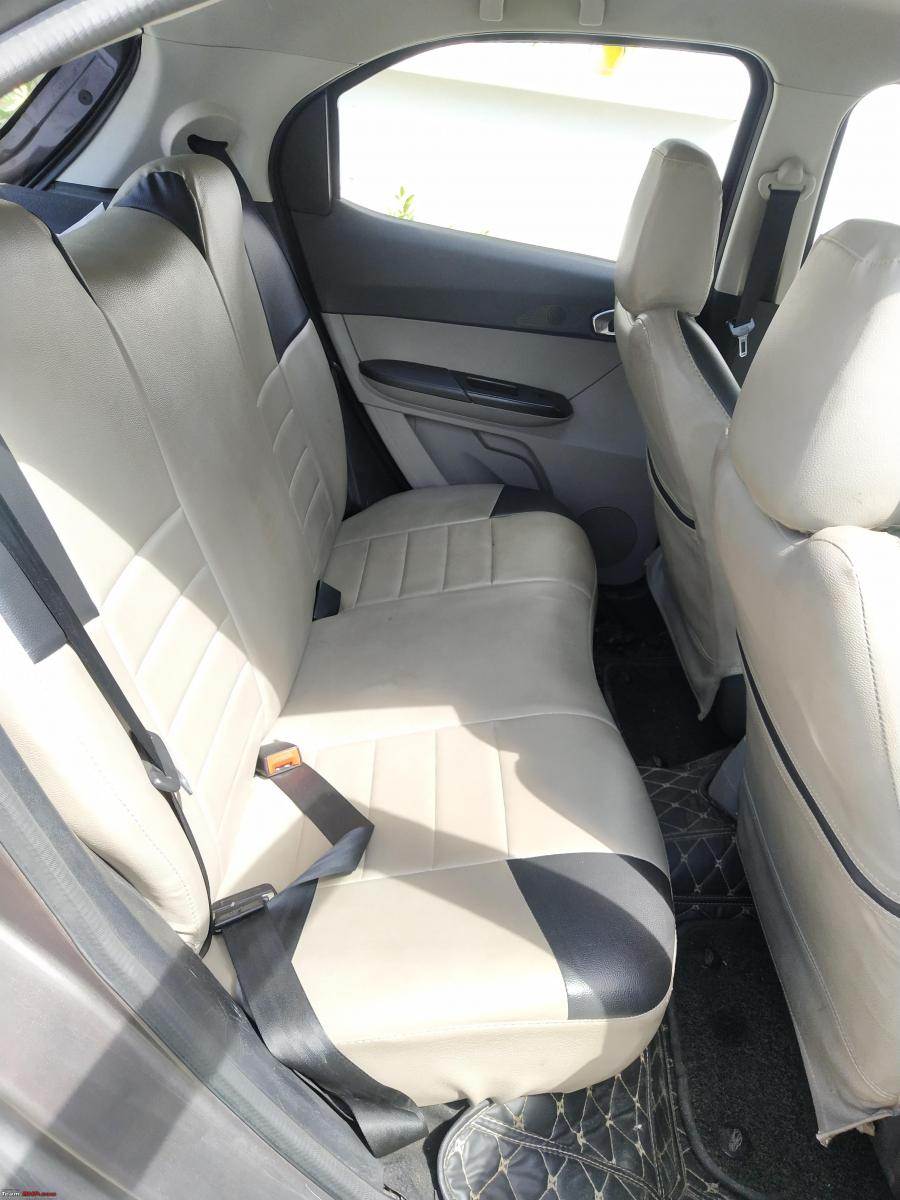

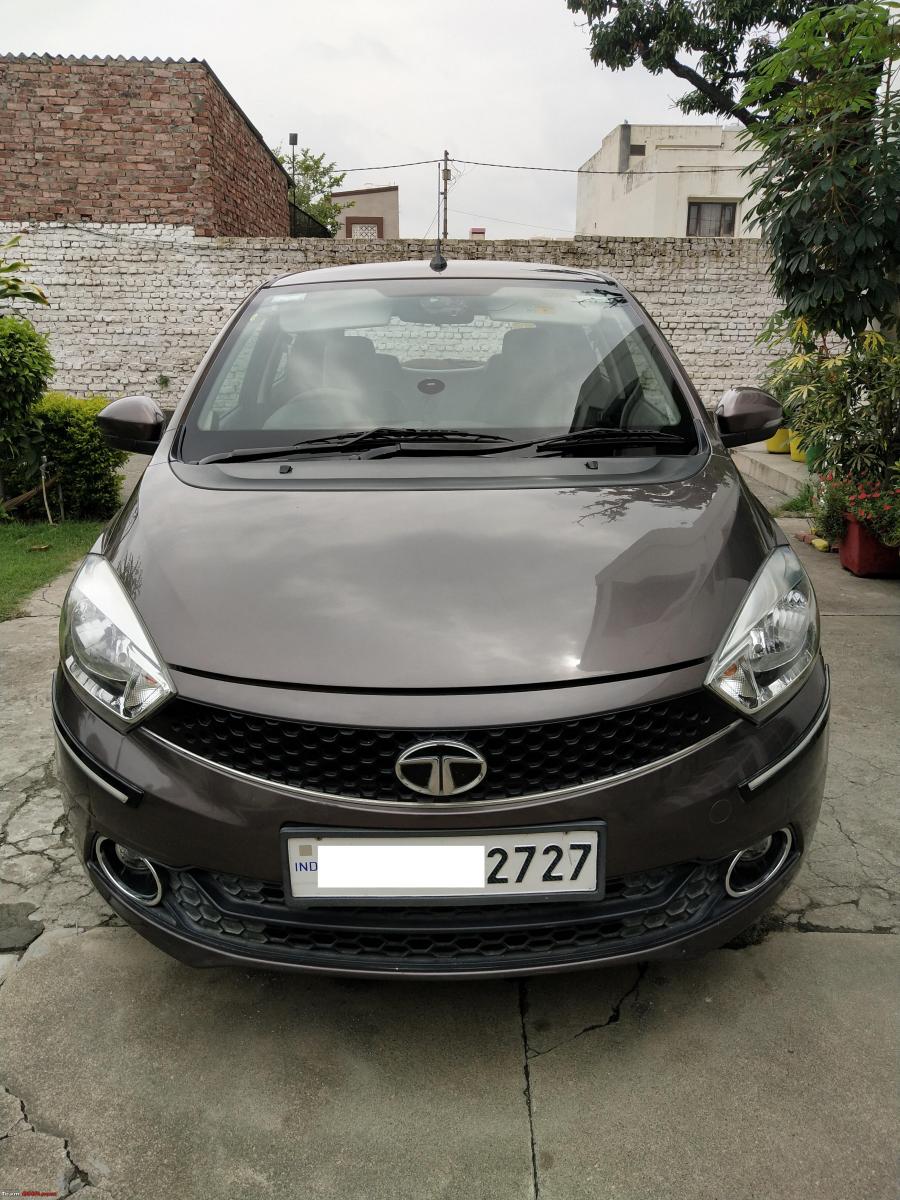

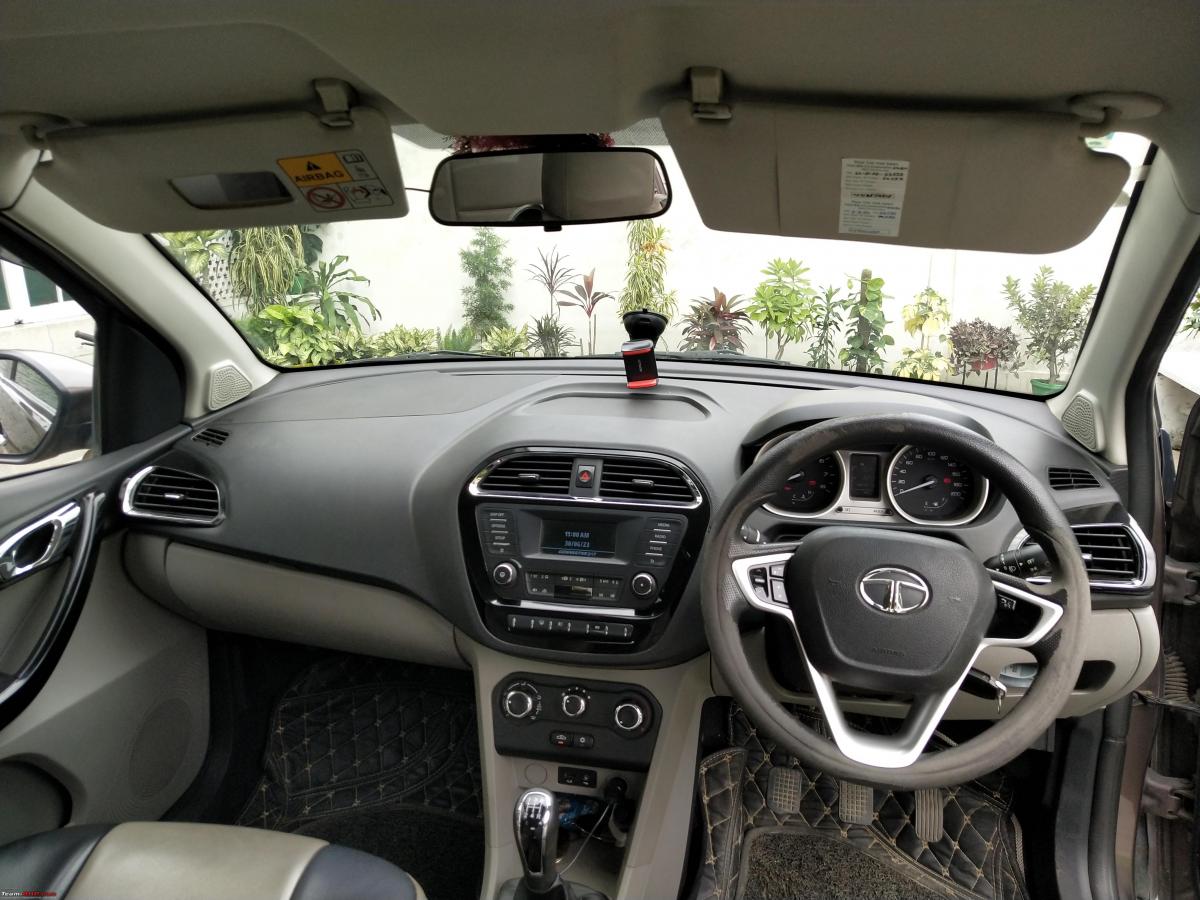

Check out BHPian comments for more insights and information.
- Tags:
- Indian
- Tata Tiago
- Tata
- Review
News
Tata Tiago sales cross the 5 lakh unit mark
Tiago is available with three powertrain options: Petrol, CNG and Electric.
Tata Motors has achieved a new sales milestone as Tiago sales crossed the 5,00,000 mark. The last 1 lakh units were sold within a span of 15 months.
According to Tata Motors, the average Tiago buyer is 35 years old. 60% of Tiago's sales come from urban markets, while rural markets account for the remaining 40%.
Tata claims that the number of women buying the Tiago has also gone up. It is said that women contribute approximately 10% of its sales. It is also popular among first-time car buyers, with 71% of its customers making their maiden purchase in FY2023.
Currently, the Tiago is available with three powertrain options: Petrol, CNG and Electric. The car is powered by a 1.2-litre petrol engine that makes 85 BHP and 113 Nm. In CNG mode, the engine makes 72 BHP and 95 Nm.
The Tiago EV comes with a 19.2 kWh battery pack offering a range of 250 km and a 24 kWh battery that can cover 315 km on a single charge.
- Tags:
- Indian
- Tata Tiago
- Sales
- Milestone
News
Crazy Tiago driver cuts into a non existing space & pays the price
I briefly stopped to see if he needed any help, but the seemingly sole occupant of the car, a well built stocky man got out and started yelling at the bus driver.
BHPian SR-71 recently shared this with other enthusiasts.
Ignore the dates in the video. This happened today 15kms before Dharmapuri. A crazy Tata Tiago driver tried to cut into a non existing space (@21s), endangering a state transport bus and a swift behind it. God knows what the moron was thinking. I briefly stopped to see if he needed any help, but the seemingly sole occupant of the car, a well built stocky man got out and started yelling at the bus driver. We moved on as there was nothing to do there other than witness a clown accuse everyone except himself for his crazy antics.
Here's what BHPian avk had to say on the matter:
One of those people who thinks that turning on the indicator gives them the superpower to move back the vehicle they are overtaking, rearrange other vehicles in the vicinity and materialize enough space for them to occupy and move ahead.
Here's what BHPian NomadSK had to say on the matter:
Weaving in and out of the traffic and He narrowly escaped a pit lane maneuver, lucky chap, would have caused more troubles for the swift & bus because of his antics.
Here's what BHPian epiccross had to say on the matter:
Is this guy dumb or drunk (or both)! Starts with a horrible manoeuver, and instead of realizing and aborting, just shoves himself ahead of the bus! Thank goodness for the presence of mind of the Bus driver to brake on time, could have been disastrous. Plus a truck ahead of him to top all that. Good lord.
The sheer gall of this idiot!
Read BHPian comments for more insights and information.
- Tags:
- Indian
- Tata Tiago
- Accident
- road rage
News
AT car for city driving in 8 lakhs: Tiago, Ignis or something else?
Should have good ground clearance considering our roads & speed breakers we have in Pune.
BHPian aniketi recently shared this with other enthusiasts.
New car dilemma:
Wife's old Santro is giving lots of problems now & is beyond repairs. No point in spending more money onto it anymore. So started looking for preowned cars and shocked to see the prices. I am not at all interested in spending 3.5 to 4 lakhs on 8 years old Wagon-R or 4.5 to 6 lakhs on 5-7 years old Grand i10 or Swift or similar cars. So started new car hunt. Budget set to 6 lakhs at first. Checked & realized no cars available in 6 lakh budget except Alto, Kwid or S-presso. Rejected all of them due to less space, small engine, poor quality. All are overall small cars for my needs.
Meanwhile wife suggested that we should go for automatic as we already have other manual car. So basically my requirements are as follows:
- Don't want low sitting car, height should be good (wife is 5.6, I am 5.11). Also mother will be sitting quite often, so big NO for low sitting cars.
- Should have sufficient features, infotainment system is kind of must along with keyless entry, steering mounted controls etc.
- Should have good ground clearance considering our roads & speed breakers we have in Pune.
- Should have good average along with sufficient engine power.
- Should have good AMT.
- Should be good looking, don't like new Wagon-R.
- Good space for 4 people along with good legroom & headroom for rear passengers.
- Within my budget of 8 lakhs.
- Good A.S.S. is must.
- Will be used mainly in city only, occasional nearby highways runs can be done. I already have other bigger, better car (Ertiga Zxi+) for highway duty and trips.
Now I have set a budget of 8 lakh on road (+/- 50k). After checking various options, I have shortlisted 3 cars mainly:
- Tata Tiago
- Hyundai i10 Grand Nios
- Maruti Ignis
Which is better car here considering my requirements? Which of the above cars has good AMT?
Here's what GTO had to say on the matter:
As good as Tata's latest cars are, their AMT is very, very sad. Too jerky, poorly tuned and the long-term reliability is proving to be patchy.
If AMT, then go for Hyundai as it's got the best one out there. Second choice, Ignis.
Since it's city usage only, you should strongly consider the Tiago EV. Butter-smooth drive, cheap running costs, Tata is king of mass market EVs.
Here's what BHPian VaibhavShatna95 had to say on the matter:
Go for i10 Nios eyes closed. I have Tiago EV and Nios in my garage and Nios looks much more modern inside out. Have also heard of great reviews for Hyundai tuned AMTs. I am 5'11 as well and with height adjustable seats its a breeze to find a decent driving position.
Not sure about Ignis but it is not a populat car from Maruti stable is what I have observed. If you want to go to Maruti way, atleast spring up for Swift and you will probably recoup your investment while selling. Baleno is so close to Swift anyways in terms of price, I went directly once for Baleno as wel.
Here's what BHPian greenhorn had to say on the matter:
The Tiago is a bad fit for your requirements - I feel the Punch is the better option.
I was in a similar situation and ruled out both Tiago and Nios because i didn't feel there was enough legroom (I'm 5'10"). I was ok with the 5 year old pre owned route so went with an etios. else would have gotten a i20 N Line.
Here's what BHPian fhdowntheline had to say on the matter:
I have a Tiago, so here are a few points having looked at those other two cars as well during the time of purchase:
- Tiago is more rugged ( mechanically).
- Low speed bumps / potholes are handled better.
- It has a surprisingly high driving position for the driver, inspite of being a hatchback. So you dont feel like you are crouched in.
- Ignis may give you a more smooth engine performance. Ingress/ egress for the rear seats will also be better, just mind the rather thick roofline and the upright seating position.
- Nios I understand now has 6 airbags and ESP in the top version, also a smoother gear shift and good initial torque, like the Tiago. AMT is less jerky. Also expect a better ICE screen experience. But Tiago's speaker sound quality is much better.
- TMSC Service experience so far for me has been " ok " . I have had better experience with Hyundai for my Creta.
- Fuel efficiency for the Maruti is likely to be the best of the lot. Tiago is ok. 13-14 in traffic, 17-19 on highways.
- Tiago's AC is probably designed for a car of the volume of Safari or higher. It is bone chilling even at 23 deg C in Auto mode.
- Tiago does not feel like a small car at highway speeds in terms of ride/ handling. But it is more noisy than the Ignis/ Nios for sure. Funnily, the speaker system has a built in compensation that enhances volume beyond say, 60 kph, probably to mask the NVH.
The Punch is better than the Tiago in most aspects ,but it may be a bit much in terms of width if you want to squeeze out of gaps.
Here's what BHPian darkfantasy had to say on the matter:
If you can wait, please wait for the Hyundai Exter. Of the 3 selected cars, if you are going for the automatic I'd choose the Nios. For your listed requirements though the Ignis feels like the perfect fit for now. The Ignis feels old inside out when compared to the Nios but mechanically should be reliable in the long run. Maruti's AMT coupled with the K12 is not far behind the Hyundai in terms of shift quality. I wouldn't consider the Tiago mainly for the ASS experience.
Here's what BHPian TheWheelDeal had to say on the matter:
As an owner of a manual Ignis Zeta, allow me to offer my perspective:
I am 6 feet tall, and there's enough space for someone of my height, even in the rear after setting the driver's seat to my position. The rear doors also open quite wide, so ingress and egress should be okay for your mother (we've used the car to transport my grandparents to doctor's appointments, and the Ignis works fine for that). However, taller folks would need to be aware while getting into the rear since the top of the door aperture is a bit low and it's possible to graze your head against it if you're not paying attention.
In terms of driving, I'm extremely happy! The engine is quite frankly a gem, and we have never encountered any difficulties with speed breakers thanks to the relatively high ground clearance. The ride quality is definitely on the firm side and personally I'm good with that, but it isn't to everyone's taste. The suspension can get noisy over bad potholes as well, but the general NVH is decent.
We did test drive the AMT which performed well enough. However, I do agree that Hyundai does it better. We ended up going for the manual because it was a better fit with the fun-to-drive nature of the engine.
We've also used the Ignis on a few road trips of about 500km total distance. The car performs reasonably well on the highway; the suspension that's firm in the city lends it stability at speed. It's capable of cruising at around 100-120kph without feeling overly stressed with 2-3 people plus luggage. With four adults and a weekend's worth of luggage, you will definitely notice a dulled response while overtaking. Do note that the engine spins at 3000rpm at those cruising speeds, which isn't ideal. Your Ertiga should serve you better on long journeys, but the Ignis can certainly handle long trips in a pinch.I get a fuel efficiency of just under 14kmpl in the city, and around 20kmpl on the highway (with the AC running full time).
As far as equipment is concerned, the Zeta misses out on a few comforts like automatic AC, height adjust driver seat, and I really do wish it had the LED+DRL headlights from the Alpha. But overall, it covers all of the bases nicely and should suit your needs well.
I still feel it's an underrated vehicle, and great value for money. Looks are subjective, so I leave that to you, but I will say that the interiors are quite contemporary and look/feel better than newer and more expensive cars from the brand. Overall, I'm quite pleased with the car and can definitely recommend it
When it comes to alternatives, I - like some other members in this thread - would suggest sticking around a little while to see if the upcoming Hyundai Exter works for you. Hyundai has the better AMT, and their ASS + network is up there with Maruti's. I suspect the NVH might be better as well. Judging by the price of the i10 Nios, I suspect the Exter may slip outside your budget, but it should still be worth considering. You could also look at the Tiago EV, although that would depend on your usage, charging infrastructure, and the reliability of the power supply in your area. I'm starting to hear that Tata's sales & service is improving, although there still seem to be a worryingly large number of complaints in the forums.
I hope this helps, and as always, do get a thorough test drive of the cars in your list! Happy shopping!
Check out BHPian comments for more insights and information.
News
Rumour: Tata Tiago & Tigor could get twin-cylinder CNG tank tech
The ALFA-based Altroz and Punch are the first models to get Tata's twin-cylinder CNG tech.
Tata Motors recently launched the Altroz iCNG with its novel twin-cylinder technology. Now, according to a media report, the company is looking to introduce the same in the Tiago and Tigor.
Instead of using a single large cylinder that takes up space in the boot, Tata Motors has developed a system consisting of two smaller cylinders that fit under the boot floor, leaving usable luggage space in the boot.
The ALFA-based Altroz and Punch are the first models to use the twin-cylinder setup. If the latest reports are to be believed, the carmaker could introduce a similar setup on models based on the older X0 platform. Currently, the Tiago and Tigor have a conventional CNG setup with a single large tank mounted in the boot.
Both cars are powered by a 1.2-litre engine that produces 72 BHP @ 6,000 rpm and 95 Nm @ 3,500 rpm when running on CNG. The engine is paired with a 5-speed manual transmission.
Source: Autocar India
- Tags:
- Indian
- Tata Tigor
- Tigor
- Tata Tiago
- Tiago
- CNG
Pages




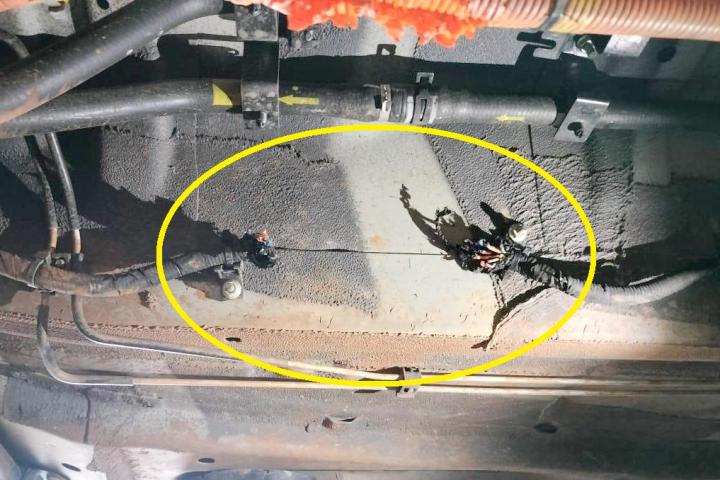











.jpg)

